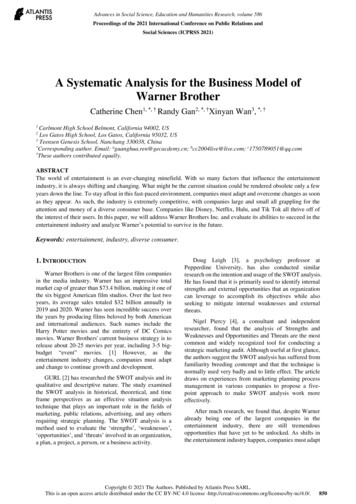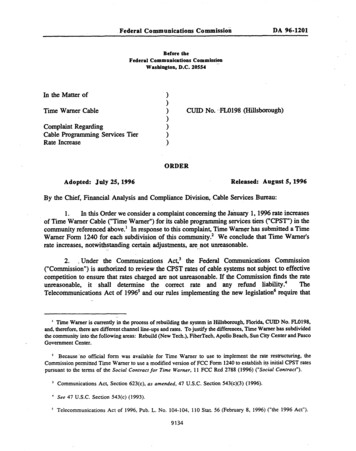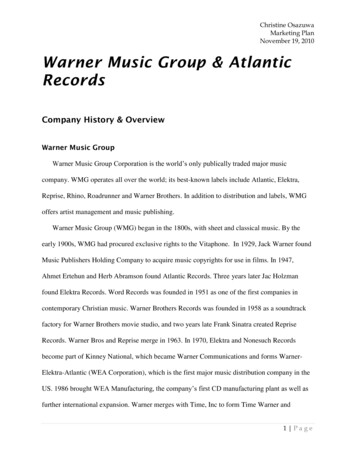
Transcription
Christine OsazuwaMarketing PlanNovember 19, 2010Warner Music Group & AtlanticRecordsCompany History & OverviewWarner Music GroupWarner Music Group Corporation is the world’s only publically traded major musiccompany. WMG operates all over the world; its best-known labels include Atlantic, Elektra,Reprise, Rhino, Roadrunner and Warner Brothers. In addition to distribution and labels, WMGoffers artist management and music publishing.Warner Music Group (WMG) began in the 1800s, with sheet and classical music. By theearly 1900s, WMG had procured exclusive rights to the Vitaphone. In 1929, Jack Warner foundMusic Publishers Holding Company to acquire music copyrights for use in films. In 1947,Ahmet Ertehun and Herb Abramson found Atlantic Records. Three years later Jac Holzmanfound Elektra Records. Word Records was founded in 1951 as one of the first companies incontemporary Christian music. Warner Brothers Records was founded in 1958 as a soundtrackfactory for Warner Brothers movie studio, and two years late Frank Sinatra created RepriseRecords. Warner Bros and Reprise merge in 1963. In 1970, Elektra and Nonesuch Recordsbecome part of Kinney National, which became Warner Communications and forms WarnerElektra-Atlantic (WEA Corporation), which is the first major music distribution company in theUS. 1986 brought WEA Manufacturing, the company’s first CD manufacturing plant as well asfurther international expansion. Warner merges with Time, Inc to form Time Warner and1 Page
Christine OsazuwaMarketing PlanNovember 19, 2010becomes, at the time, the world’s largest music publisher. Throughout the 1990s, Time Warnerwas the largest media company in the world. Digital and streaming media becomes prominent inthe early 2000s. WMGreen, an industry-leading environmental initiative, is launched in the mid2000s and WMG became listed on the New York Stock Exchange. (Warner Music Group).Atlantic RecordsFounded in 1947, Atlantic built a reputation through developing artists such as Ray Charles,being comprised of primarily R&B and jazz artists. Atlantic was acquired by Warner Brothers in1967 and was run separate from Warner Bros and Reprise Records. During this time, Atlanticsigned Led Zeppelin, solidifying its place in music history. The subsidiary labels combined toform Warner Music Group (WEA). In total, the label has over three-hundred artists on its rosterand continues to be self-distributed (Warner Music Group).Executive SummaryThe rise in digital music sales has been affecting Warner Music Group for the past decade.Because of the increased availability of cheap or free music on the internet, WMG has to findnew and innovative ways to transform their company and continue to keep themselves relevantin an ever-changing market. People are asked to play multiple roles, from within the corporationranging from creative people in the offices to the performers that become actors, singers anddancers in order to be a part of the WMG Disney Empire.Because of the new measures in place by WMG and its subsidiaries such as Atlantic Records,their stock prices often fluctuate due to touring sales rather than music sales. In the past year,WMG has approached banks for a “bail-out” which has also affected their stocks and the waypeople, including the stockholders, view of the company. WMG major labels must now compete2 Page
Christine OsazuwaMarketing PlanNovember 19, 2010against, not only other major labels but against independent labels that are now actually having alarge impact on music sales thanks to sites like iTunes.Many artists are choosing to leave their labels and support themselves financially andcreatively, even releasing entirely free albums, such as with Radiohead. WMG has beenstruggling to compete and revise a business model that worked before the download age, but nolonger works.Branding of the label, itself, and the artist can prove beneficial in the battle between physicaland digital. More personalized marketing can build integrity that major labels are perceived tolack, and “360 Deal” also known as a "Multiple Rights Deal" should be implemented moreregularly. The term is used in the music industry to describe special branding of musicians.Contracts allow record labels to receive a percentage of earnings from all of a band's activities,not just their music sales, such as ticket sales, merchandise sales, endorsement deals andringtones. In exchange, musicians receive support from their label for longer periods (possiblythe duration of their career) in all aspects of their career including providing merchandise,management, legal services, extensive marketing, and tour support.SWOT AnalysisStrengthsBeing a large corporation owned by an even larger corporation, Atlantic Records has the 60years of history and the 200 years of history, its parent company possesses as a strong indicatorto investors. Unlike smaller start up labels, they have years of experience to build confidencewith those involved. In addition, because of the large parent company, most things can be done3 Page
Christine OsazuwaMarketing PlanNovember 19, 2010in house such as marketing, distribution, and designing; thus keeping a cohesive brandthroughout the company with each artist. This cuts down cost of development and keeps the linesof communication uncluttered, as they would be with outsourcing and dealing with multiplecompanies.Atlantic Records is credited as the first label to have 50% of its sales from digital outlets, soit has obviously learned to embrace the digital market well, and much better than some of itscompetitors. It also has to ability to generate great radio play for many of their artist stayingconstantly on top of Billboard charts and radio Top 40 lists.WeaknessesBrandingAtlantic Records has been around for over 60 years, developing some legendary artists. Thered logo and typeface has stuck with Atlantic since almost its inception. General consumerperception sees Atlantic as an All-American label with strong roots. Unfortunately, they have notdone enough to build brand loyalty. Recently they developed the Atlantic Records Time Capsule,a 100 box set of records, documents and other media from the last 60 years, however; nopressure was placed on the sales of the box set. The idea of capitalizing on the label’s successesand history is a sound, unfortunately, it is difficult to adhere to your classic roots while stillexpanding and changing with the times.Independent labels are far better at creating a brand because they often only focus on onetype of artist or from one region, as opposed to Atlantic that covers many artists, and genres allover the world. Smaller labels create merchandise for not only their artists but for their ownlabel. The fans of the label are able to show their support for the label through this merchandise.4 Page
Christine OsazuwaMarketing PlanNovember 19, 2010Because of the intimacy of one genre or region, fans build a sense of familiarity with smallerlabels. The development of subsidiary labels such as Photo Finish Records and Fueled by Ramenshow that Atlantic has an ability to build and develop this brand loyalty on a smaller basis, buthas failed to do so on a larger scale.OpportunitiesThe popularity of Multiple Rights Deals have become a new way for labels to regulate cashflow and keep a consistent roster. Atlantic has the opportunity to embrace this form of deal. Inaddition, new digital practices are being developed and implemented every day that can changethe face of the music industry, not kill it, like many like to predict but mold it into something thatwas not there before. New technology always brings about new opportunities.ThreatsIllegal downloading has been the biggest threat to the music industry, as a whole. Embracingdigital music has been the redeeming feature for Atlantic, but album sales will never be as theywere in the 90s and early 2000s. The threat of albums becoming obsolete and a switch toconstant singles or EPs is very real. The label may choose to embrace that, or continue with thetraditional practice of a new album every 12 to 18 months.Industry AnalysisThe 21st Century has brought about challenges to the music industry with technologicaladvancement of music distribution. Digital music poses a special challenge for musicians andrecord labels. In the early stages of file sharing and music download, it was uncertain whethercompanies should embrace the practice or banish it. While lawsuits and legal issues still occur5 Page
Christine OsazuwaMarketing PlanNovember 19, 2010often with music downloads, it is nearly impossible to succeed in the music industry withoutaccounting for legal and illegal music downloading, “IFPI estimates around 95 percent of tracksare downloaded without payment to rights holders” (International Federation of thePhonographic Industry 5) .Multiple Rights Deals has become a solution to the 20% per year decline in physicalalbum sales over the past seven years (Burns 1). “With the new wave of recent contemporarypop (artists like Hilary Duff, Miley Cyrus and the Jonas Brothers), Disney has created asustainable ‘machine’ – a generation of 360 Deals where the ‘branding’ of artists and creation ofother products (in addition to CD's) drives profits” (Valletutti). Labels argue, “It doesn’t makesense for labels to pour money into artist development when CD sales, their primary source ofrevenue, continue to decline,” (Arrington 1). With these deals, labels receive a cut of artists’revenue from touring and merchandise sales, but labels normally supply the seed money forthese endeavors. Obviously, the labels could not make money without the artists, but now thelabels are retaliating that the artists cannot make as much money without them.Walt Disney Records’ High School Musical audio franchise, that features some ofDisney’s current roster of label artists, was the number one best-selling album globally for thetwo consecutive years, selling 7 million units in sales (Disney). Walt Disney Records has used360 Deals to their advantage, for what their New Media Director, Matt Fitz-Henry claims to bethe past 50 years (Valletutti). Though this formula has worked and continues to work for Disney,the recent rise in popularity has brought heavy debate about the positive and negative aspects ofMultiple Rights Deals and the future consequences that may arise from branding artists.Disney targeting young adolescent girls to market their music is an example of practicingmodern economist methodology, because this age group receives money from their parents. “Of6 Page
Christine OsazuwaMarketing PlanNovember 19, 2010the reported US 51 billion spent by tweens themselves, an additional 170 billion was spent byparents and family members directly for them” (Mesa 1). Disney Records specifically targets“tweens” and because of this “Miley Cyrus's two-disc Hannah Montana 2/Meet Miley Cyrusalbum sold 326,000 CD's and debuted at the top of Billboard album charts” (Valletutti). Whilethe data is present for album sales, Hannah Montana also has extensive merchandise, including atoothbrush that plays her single. While not as easily measurable as CD sales, it is still relevant inthe scheme of Multiple Rights Deals.Current StatusFinancial StandingIn 2009, WMG experienced a sharp decline in its stock due to unexpected changes in itsfixed operating costs. The company hit its lowest trading point in March 2009 trading at less than 2, in recent months the company has traded at around an average of 5. Warner Music Groupholds a 1.9 billion long-term debt and continues to cut costs to keep pace with shrinkingrevenue (Munarriz).Product“Although the concept of promoting artist development in order to increase revenue streamsexists in the minds of major record label executives, they should extend their efforts beyond the‘artist’ and into the ‘product’” (Valletutti). The goal of Multiple Rights Deals is to have acohesive overall plan for an artist.7 Page
Christine OsazuwaMarketing PlanNovember 19, 2010The way an artist is marketed, from their look, their appearances, where their music isplayed or sold, and where they tour, are all a part of this effort to make the band a brand. In asense, a band becomes like a corporation with different departments controlling aspects of alarger business plan. Al Branch, general manager at Hip Hop Since 1978, an artist managementfirm, sees the future of recording labels as companies “establishing recording divisions, touringdivisions and so on, to run these talented people. Labels are going to see artists as brands and notjust people who can sing or rap really well.” (Burns 2).Recent ChangesPreviously music was the value that customers sought after; however, the need for music hasbeen filled through technology. In response, labels must supply their consumers with analternative to music since that can be acquired easily through the internet. In order a firm toremain relevant “the firm must sustain this process of creating and capturing value over time”(Silk 2). The concept of 360 Deals involves labels evolving over time to provide continuousvaluable goods to their customers.The argument for stealing music is that from an economic standpoint some believe thatdigital music should be free. Once software to record music is already present, there is no cost toproduce another copy of digital music. Unlike cassettes of the past, any additional digital copiesmade are just as good as the original. Because of this there is perfect competition and zerobarriers to entry, evident through social networking sites."MySpace, for example, lists more than2.5 million hip hop acts and 1.8 million rock artists alone” (International Federation of thePhonographic Industry). “Unless effective legal (copyright), technical (DRM) or other artificialimpediments to production can be created, simple economic theory dictates that the price of8 Page
Christine OsazuwaMarketing PlanNovember 19, 2010music, like its marginal cost, must also fall to zero as more ‘competitors’ (in this case, listenerswho copy) enter the market” (Arrington).Free music is used as a marketing tool within itself. Well-known and established artists,such as Prince and Nine Inch Nails have given away full albums free. Prince’s goal was toincrease excitement for his 21-city tour. UK band, Radiohead made their entire seventh albumavailable online and allowed their fans to “pay what they want” before the album’s physicalrelease date to promote the CD. The album reached number one on the US and UK BillboardCharts (Billboard 1).The idea that people will purchase an album after they already acquired it for free challengesa modern economists methods of data analysis, the demand for the album should have ceasedafter being made available for free, however; a post-modern economist denies the role ofmethodology (Repko 107) relying solely on situational differences. Because of the way a bandbuilds and creates loyalty, the fans are willing to continuously support a band in its efforts, thusthe value of the music is directly correlated with how much a consumer values an artist.Marketing PlanBecause each artist on a label has set specific goals and different means to achieve thosegoals it’s difficult to have a blanket marketing plan for an entire label, especially one likeAtlantic that does not focus on one genre or even one nation. Because of the nature of mediacompanies, a focus strictly on finances may harm the creative integrity of the corporation, whichis something major record labels have been facing for decades.Branding9 Page
Christine OsazuwaMarketing PlanNovember 19, 2010A marketing plan for Atlantic Records would first need to achieve the goal of branding eachartist. Building brand loyalty for an artist is an effective way for repeat buying. Fans are morewilling to purchase and find everything an artist has created the more loyal they feel to that artist.KISS is an example of how a brand can generate revenue outside of simple music sales.Company Re-DesignWith the new record label, the monetary gains (or losses) cannot be the only judge of asuccessful business. A label may put money into an artist with 360 Deals, but may not seeimmediate returns. Because of this, other aspects must help decide how successful a label is.Departments will have to show their effectiveness, for example, the public relationsdepartment will have to show the financial officers how visible their artists are in magazines,online, on television, etc. The economist and marketing director would then have to worktogether to create a plan that accesses the relationship between artists’ visibility and potentialprofits. The revenues department that has more defined goals will have to check the moreabstract departments for tangible evidence of potential gains.In an effective deal, an artist should be incorporated in the goal-oriented process in orderto check that they are being presented the way they would like. If an artist is involved with theprocess it can help avoid exploitation of an artist since most labels do not have a way toincorporate ethics into their business plans.Non-Traditional & Digital SalesThough album sales are in decline, general music sales are substantially higher than theirpast. Music sales exceeded 65 million in the final week of 2008, representing the biggest salesweek in the history of Nielsen Soundscan (Neilson Soundscans). Therefore, it is not that people10 P a g e
Christine OsazuwaMarketing PlanNovember 19, 2010are not buying music; people simply are not buying albums. Digital sales, ringtones, and singlescontinue to increase. Even vinyl sales are at a high from the inception of Soundscan in 1991,selling about 2 million copies in 2009. Capitalizing on the sale of individual songs can beprofitable in the short term for an artist while they work to develop their brand.Albums can still sell well in the new label format by providing something that cannot bereplicated through the internet. Special album artwork, supplemented free merchandise, or tourexclusive content can help drive physical album sales in an otherwise hectic market. Somemusicians have reverted to cassette tapes as a novelty item, while providing the digital tracksfree.Album sales at Non-Traditional music outlets (digital, internet, mail order, venue, nontraditional retailers) hit an all-time high in 2009 with sales reaching 110 million. Non-Traditionalis the only strata that experienced album growth over the previous year; with an increase of 11%over 2008, and accounting for nearly 10% of overall music sales in 2009 (Neilson Soundscans).Free MusicInstead of treating music as a commodity to be sold, for many artists, music should be usedas a marketing tool. Distribution and availability of free music still has an appeal to manyconsumers. In addition, it builds awareness of an artist that a consumer may not have necessarilyheard had the music not been free. The distribution of free music can then lead to touring andmerchandise sales.In the case of a major label distributing free music, it makes the label look more consumerfriendly, thus helping rid the stigma of a big business and consumerism. Making the free musicavailable on the label website or social networking sites can build brand loyalty to the label as11 P a g e
Christine OsazuwaMarketing PlanNovember 19, 2010people will turn to Atlantic as a source for free music, like they may do for other (possiblyillegal) sites.Online “Licensing”While labels have always had large licensing departments to get artists songs on televisionprograms and movies, the internet is a much cheaper form of real-time licensing. Instead ofdemanding the take down of songs from YouTube videos, it might be more beneficial forAtlantic to embraced these music videos and use it as product placement. Obviously, in order tomaintain the integrity of the label and artist’s brand they may not want to endorse every videothat chooses to play their song. Incorporating software that will help others discover what artist isplaying and how to find them online would be a good way to reach millions of YouTube userswith little to no extra labor or money. In an oversaturated market, exposure is key to developingan artist and limiting the amount of exposure on sites like YouTube tends to do little more thanmake labels look like the bad guys.Cheap MarketingMore responsibility should be placed on free and cheap marketing labor, street teamers, forexample, have been essential to record labels for years. An easy and financial savvy way forlabels to build relationships with artists, small media outlets, DJs, bars, clubs and other keylocations are through street teamers. A switch must be made from impersonal generic marketing,e.g., online banners, targeting only large arena shows, and generic social networking usage, tocommunicating with individuals both online and in person based on tastes, interests, andlocation in order to have a more relevant base for artist. A team of individuals working topromote artists for free concert tickets, and other small cheap prizes shows a personal intimate12 P a g e
Christine OsazuwaMarketing PlanNovember 19, 2010relationship that smaller labels have, and helps to reach publications and media sources thatlabels often overlook.ProjectionBecause it is the only publically traded major music company, it is difficult to compare tocompetitors in terms or revenues and investors. It is projected that WMG revenues in the fourthquarter of 2010 will fall by 14%, while digital sales will only increase by 1%, which will notcompensate for the projected 20% decrease in physical album sales (Benzinga).With increased branding, the way consumers view Atlantic Records, WMG and its artist canmake a paradigm shift that could help the company stand out from the other three conglomerates.Building a large loyal fan base will allow artists to experiment with new directions and sounds,while keeping revenue steady through touring and merchandise. The focus on multiple rightsdeals, while controversial, will make it easier for artists to keep their creative integrity. Theallowance of consumer to shape their own experience through free music, and licensing throughonline outlets will make the label more consumer friendly, thus making Atlantic seem less like a“suit” and more like a creative entity, whose goal is to release authentic music as they did 60years prior.13 P a g e
Christine OsazuwaMarketing PlanNovember 19, 2010Works CitedArrington, Michael. "“360″ Music Deals Become Mandatory As Labels Prepare For Free Music." 8November 2008. Tech Crunch. 15 December 2009 c/ .Benzinga. "Citigroup Expects WMG Revenue To Fall 14%." 16 November 2010. Benzinga. 17November 2010 More responsibility should be placed on free and cheap marketing labor, street teamers,for example, have been essential to record labels for years. An easy and financial savvy way for labels tobuild relationships with artists, small media outlets, DJs, .Billboard. "Radiohead Nudges Blige From Atop Album Chart." 2 February 2008. Billboard. 15December 2009 http://www.billboard.com/bbcom/news/article display.jsp?vnu content id 1003694375#/bbcom/news/article display.jsp?vnu content id 1003694375 .Burns, Renita. "Black Enterprise." 4 December 2009. Multiple Rights Deals Changing How RecordLabels Make Money. 15 December 2009 ake-money .Disney. Walt Disney Records’ High School Musical Audio Franchise Makes Global Chart HistoryFor Second Consecutive Year. Press Release. Burbank, 2008.International Federation of the Phonographic Industry. Digital Music Report 2009. London: IFPI,2009.Masnick, Mike. "Are The RIAA's 750-Per-Song Fines Unconstitutional?" 3 May 2006. Tech Dirt.15 December 2009 shtml .Mesa, Alicia de. "Marketing and Tweens ." Business Week 12 October 2005: 1.Munarriz, Rick Aristotle. "Rick Aristotle Munarriz." 18 November 2010. Fool.com. 19 November2010 hrow-this-stock-away.aspx .Neilson Soundscans. 2009. 18 November 2010 http://www.billboard.biz/bbbiz/charts/chart alert/index.jsp .14 P a g e
Christine OsazuwaMarketing PlanNovember 19, 2010Silk, Alvin J. What Is Marketing? Boston: Harvard Business School Press, 2006.Valletutti, Lisa Marie. "Perfect Sound Forever." June 2009. 360 Deal or No Deal. 15 Decemeber2009 http://www.furious.com/perfect/360deals.html .Warner Music Group. Warner Music Group Annual Report. 2009. 19 November 2010 http://phx.corporateir.net/External.File?item UGFyZW50SUQ9MjYxMDd8Q2hpbGRJRD0tMXxUeXBlPTM &t 1 .White, David Manning. "Popular Culture: The Multifaceted Mirror." White, David Manning and JohnPandleton. Popular Culture. San Diego: Publisher's Inc., 1977. 8-17.15 P a g e
Warner merges with Time, Inc to form Time Warner and . Christine Osazuwa Marketing Plan November 19, 2010 2 P a g e becomes, at the time, the world's largest music publisher. Throughout the 1990s, Time Warner . SWOT Analysis Strengths Being a large corporation owned by an even larger corporation, Atlantic Records has the 60
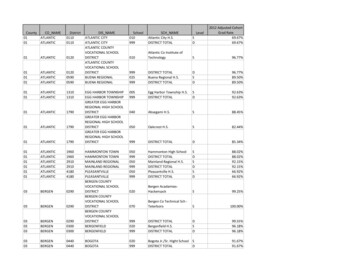
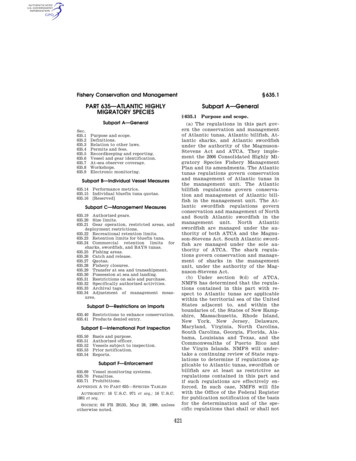

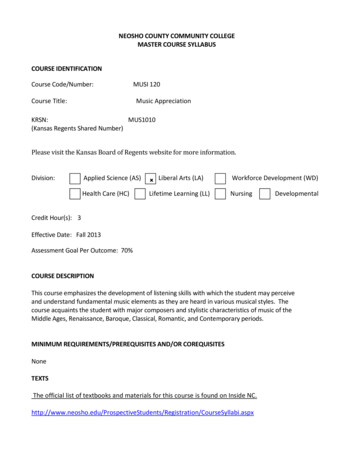
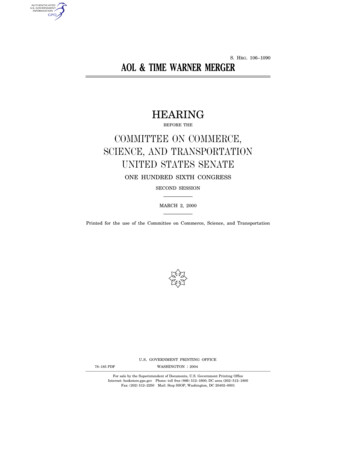
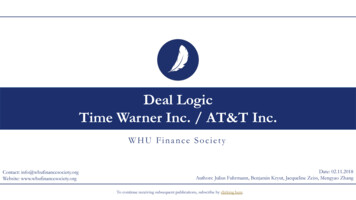

![To Kill a Mockingbird [cs] - Summer Reading 2017](/img/29/to-kill-a-mockingbird.jpg)
